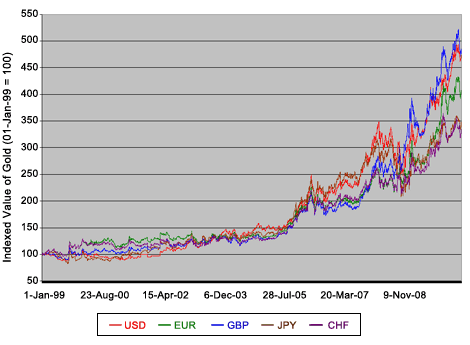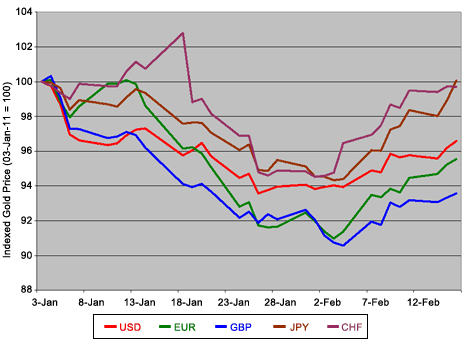For some investors, the headline question is a forgone conclusion. For others, gold's price destination isn't so certain. Answering the question in great part depends upon one's time horizon.
Traders tend to have short - or shorter - investment horizons. That's not to say that they may not hold gold core positions for the long term. Many do, while they trade in and out of gold to capture intermediate- or short-term price trends.
Traders also have a choice of currency in which to trade. Bullion's gains and losses can be levered by trading in sterling, Swiss francs, euro or yen instead of U.S. dollars.
Gold's longer-term price track has been upward in all the reserve currencies since the launch of the euro in 1999, although the average rate of appreciation varies. You would, for instance, have earned the best average return if you'd bought your gold in sterling; less if your original purchase was in Swiss francs.
Gold Price (Jan. 1, 1999 to Feb. 16, 2011)
| Currency | Average Annual Return |
| USD | 14.6% |
| GBP | 14.8% |
| EUR | 13.1% |
| JPY | 11.6% |
| CHF | 11.1% |
There were plenty of peaks and valleys, however, that one could have traded as gold worked its way higher (or, from another viewpoint, as currencies worked lower). For example, gold appreciated at a higher rate against the euro early in the currency's career. Then, as its appreciation against the euro dipped, gold began trading higher against the greenback and the pound:
Gold Price Since 1999

Over the past couple of years, there's been a lot of volatility in bullion's price across the forex market. Notice, in particular, the reversal of the euro's fortunes compared to the Swissie and yen.
Recent Gold Price Trend
| Currency | 2009 Return | 2010 Return |
| USD | 25.0% | 29.0% |
| GBP | 22.9% | 32.8% |
| EUR | 13.6% | 39.5% |
| JPY | 25.6% | 14.0% |
| CHF | 22.9% | 16.9% |
Viewed from a peculiar perspective, the U.S. dollar seems almost stable. Or at least its rate of degradation against gold has been more consistent.
And now? How has gold fared against the major currencies in 2011?
Gold lost ground against all the reserves early on, but by varying degrees. Generally, 2010's year-end downtrend carried over through January. But now we're seeing the signs of a rebound.
Gold has bounced the most in Japanese yen, now trading above - albeit by just 0.5% - its New Year's Day price. Meanwhile, it has been weakest against the euro, down 6.5% since the top of the year. Still, that's an improvement from its 9.5% dip earlier this month.
Gold's track record in dollars has been, for lack of a better word, middling. It didn't fall as much as some other currencies, but it didn't - or hasn't yet - rebounded as much as others, either. In dollar terms, bullion remains 2.6% underwater for the year:
Gold Price In 2011

We're now at a point where gold prices are likely to stage a sustainable rally; that is, if certain resistance points are taken out. The most critical point, in dollars, is $1,393/oz. Decisive closes above this mid-January high in spot prices could set the stage for bullion to take out its former highs.
So, just how high is high? Well, if the stars align rightly - or more appropriately, if the fear index continues to be cranked up by doings in the Mideast - that could mean $1,478/oz.
It's likely to be a short throw, too. If we get a breakout move immediately, it might take just a month or so.
(For GLD investors, the breakout level would be $135.70 with an objective of $143.50.)
The more interesting question is where gold goes from there. Will this be just another stair-step to yet higher prices, or will this be the final thrust that finishes the gold bull off? A bit of fog still remains in our crystal ball, but we'll be sure to let you know when it starts to clear.
We'll look at the implications for other currency/gold cross rates in the coming week.
No comments:
Post a Comment